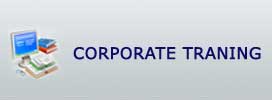Courses Offered :
ADF & Web Center
ADF – Application Development Faces & Web Center
- Understanding UI Technologies
- Describe the use of Web browsers and HTML.
- Explain how Java has come into widespread use as a language for developing Web applications.
- Describe the function of Servlets and JSPs.
- Define JavaServer Faces.
- Explain the JSF component architecture.
- Explain some JSF component types included in the standard implementation.
- Describe the purpose of backing beans.
- Describe the JSF life cycle.
- Explain how ADF Faces augments the JSF life cycle.
- Binding UI Components to Data
- Create an empty JSF page.
- Use three different ways to add ADF Faces UI components to a page.
- Describe the types of data-bound components that can be added to a JSF page.
- Describe the structure of an EL (Expression Language) expression.
- Introduction to Fusion and ADF
- Describe Fusion Architecture.
- Explain how ADF fits into the Fusion architecture.
- Describe the ADF technology stack (MVC).
- Identify sources of additional information about ADF and ADF Business Components.
- Getting Started with JDeveloper
- Describe benefits that JDeveloper provides for application development.
- Utilize common IDE mechanisms when developing and testing components.
- Set IDE preferences based on user requirements.
- Initiate the creation of empty applications, projects, and connections in JDeveloper.
- Building a Data Model with ADF Business Components
- Describe the role of ADF Business Components in building a business service.
- Explain the architecture of ADF BC.
- Identify the types of components that cooperate to provide the business service implementation.
- Explain how ADF BC components are used in a Web Application.
- Querying and Persisting Data
- Describe the characteristics of an ADF BC view object.
- Create a view object that can be used for performing a query in a Web application.
- Define a SQL statement on which to base a query for a view object.
- Explain how entity objects relate to database tables.
- Describe the persistence mechanism of entity objects.
- Use the Create Entity Object wizard to generate entity objects from database tables.
- Create associations between entity objects to represent business relationships.
- Create updatable view objects based on entity objects.
- Link view objects to one another in a master-detail hierarchy.
- Refactor objects in an application.
- Exposing Data to Clients
- Explain the role of application modules.
- Describe the characteristics of application modules.
- Use the Create Application Module wizard to define the data model for an application module.
- Explain how application modules can manage business components transactions.
- Explain how application modules can manage application stateE.
- Explain the role of the ADF Model.
- Implementing Navigation on Pages
- Implement command buttons and links.
- Create menus - Menu bar.
- Create menus - Popup.
- Create menus - Context.
- Use a navigation page.
- Use breadcrumbs.
- Create trains.
- Achieving the Required Layout
- Build complex page layouts with layout components.
- Explain the role of ADF Faces skins.
- Use dynamic page layout.
- Ensuring Reusability
- Identify the benefits of reusing components.
- Create a resource catalog to enable sharing of resources within and across teams and applications.
- Create ADF libraries to share components within and across teams and applications.
- Create a task flow template for reuse across different bounded task flows.
- Create a page template for reuse across the JSF pages in an application to enable a consistent look and feel.
- Create a declarative component for reuse in different pages of an application.
- Create a page fragment to use in multiple pages of the application.
- Employ a bounded task flow as a region in a JSF page.
- Passing Values between UI Elements
- Evaluate whether the data model contains opportunities to reduce the need for passing values between pages.
- Use a managed bean to pass values between JSF pages.
- Store values in memory-scoped attributes to hold and pass information between pages and life cycle phases.
- Use parameters to pass information to different parts of the application.
- Implementing Security in ADF BC Applications
- Explain the need to secure applications.
- Describe security aspects of an ADF BC application.
- Add ADF Security Authentication to an application.
- Add ADF Security Authorization to an application.
- Use two approaches for granting users access to resources.
- Prevent unauthorized access to the ADF BC Model.
- Explain the types of application authentication at run time.
- Use Expression Language to extend the default security capabilities of the framework.
- Oracle Jdeveloper and ADF
- Explain JSF, ADF Faces Rich Client, ADF Business Components
- Create a Page Template and Layout
- Build a ADF Task Flow using Business Components
- Configure Partial Page Refresh
- Oracle WebCenter Framework
- Identify WebCenter Suite Components
- Describe Framework, Composer and Services
- Explain WebCenter Architecture and role of MDS
- Integrate a Portlet within WebCenter
- Build and Deploy a Portlet
- Implement Interporlter communication
- Installation and Configuration
- Describe WebCenter Install Process
- Use the Performance and Diagnostics tools
- Configure a custom application with WebCenter Services
- Export/Import WebCenter Applications




